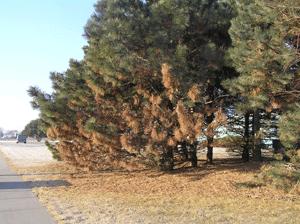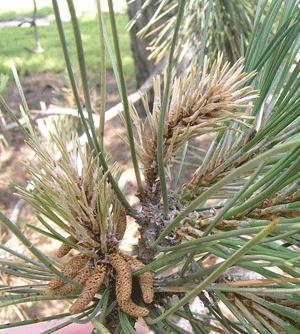Now is the Time to Control Diplodia Tip Blight of Pine
Browning and death of branch tips is quite common in older, well-established pine plantings. Such damage is often due to Diplodia Tip Blight, (syn. Sphaeropsis tip blight). Infection kills current-year shoots and eventually may kill whole branches. This causal fungus becomes increasingly more common and destructive as trees age, although young trees can be affected. Austrian pine is the most severely affected of the pines, but Ponderosa pine, Scotch pine and Mugo pine are also susceptible.
Symptoms
The most conspicuous symptoms of Diplodia tip blight are stunted new shoots with short, brown needles still partially encased in their sheath. Infected shoots are quickly killed and may be located throughout the entire tree, although damage is generally first evident in the lower branches. The severity of damage may vary considerably throughout the tree, with some branches that have been infected several years in a row dying back completely. After two or three successive years of infection, treetops may also be extensively damaged. Repeated infections reduce growth, deform trees and ultimately kill them.
Small, black, pimple-like structures develop at the base of infected needles and on the backside of pine cone scales. These structures produce additional fungal spores that can re-infect the tree.
Pests Causing Similar Symptoms
Diplodia tip blight can be confused with damage from pine tip moths; however, pine tip moth damage can be distinguished by the presence of larvae or tunnels found when the affected shoot is slit open. It should also not be confused with pine wilt, a diseased caused by trunk-dwelling nematodes, which is killing many pines across Nebraska. Pine wilt primarily affects Scotch pine trees, and kills the entire tree very quickly. Usually within a matter of 2 or 3 months.
Control
New shoots are most susceptible during a two-week period starting when the buds begin to open and continue to be susceptible through mid-June. Infections are worse during years with very wet spring conditions, which promotes disease infection. High humidity also promotes the germination of spores. Fungus spores are dispersed primarily on rain splash from March to October.
Two applications of fungicide are normally recommended for application during the third week in April and a second application in the first week of May for eastern Nebraska. However, with this spring's unusually warm conditions has resulted in earlier tree growth than normal. So this year, applications should be made now or as soon as buds at the tips of the branches begin to open, with a second application 7-10 days later. Bordeaux mixture, liquid copper (Tenn-Cop 5E) or fixed copper (Basic copper sulfate, Tribasic copper sulfate) are effective in treating this disease. Read and follow all label directions carefully before application.
More information: Diseases of Evergreen Trees, Nebraska Forest Service Sphaeropsis Tip Blight of Pine, University of Nebraska- Lincoln Extension


